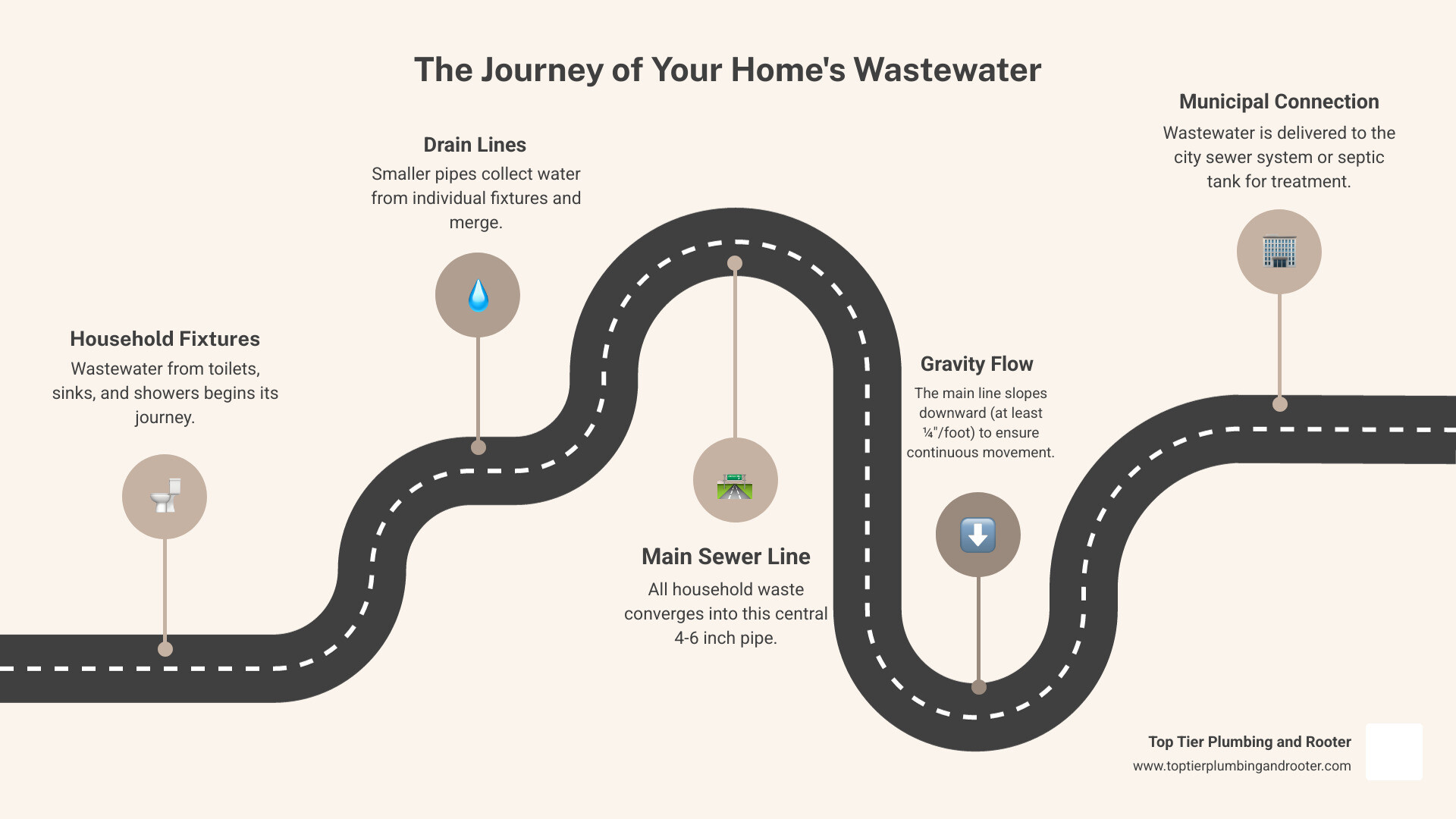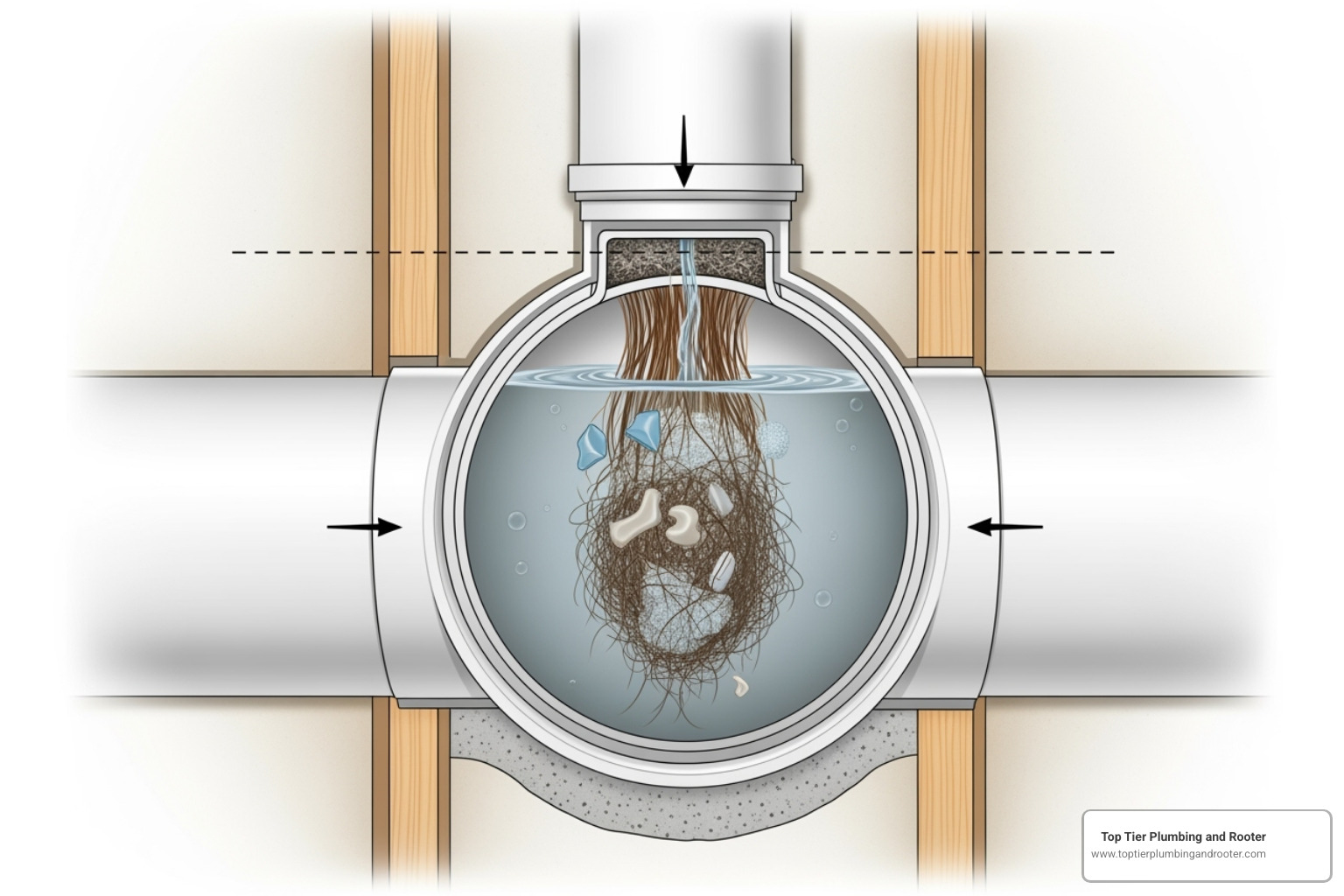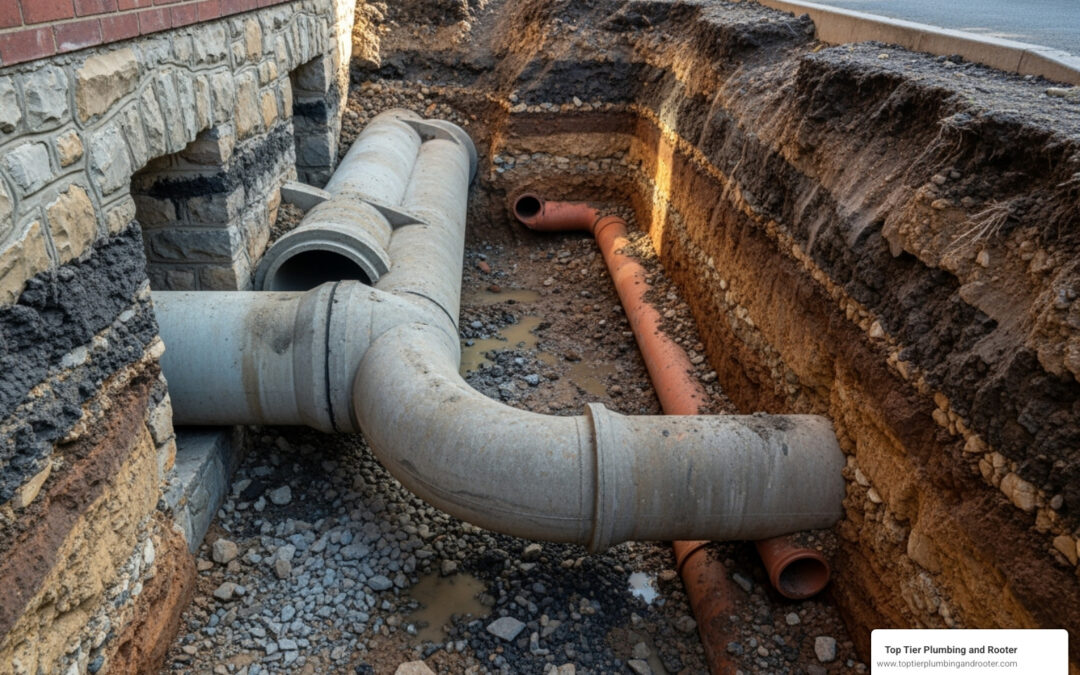What Every Homeowner Needs to Know About Their Main Sewer Line
Your main sewer line is the large underground pipe that carries all wastewater from your home to the municipal sewer system or septic tank. It’s essentially the highway for everything that goes down your drains, toilets, and appliances.
Quick Facts About Main Sewer Lines:
- Size: Typically 4-6 inches in diameter
- Function: Collects waste from all household drains and fixtures
- Location: Underground, usually running from your home to the street
- Responsibility: Homeowners typically own from their house to the property line
- Lifespan: 50-100 years depending on material and maintenance
Think of your main sewer line as the central highway of your home’s plumbing system. Just like how all the smaller roads in your neighborhood eventually connect to a main highway, all the drain lines from your sinks, showers, and toilets eventually connect to this single main pipe.
The main sewer line operates on gravity, sloping downward at least ¼ inch per foot to keep wastewater flowing toward the municipal treatment facility. When this critical pipe fails or gets blocked, it doesn’t just affect one drain – it can cause sewage to back up throughout your entire home.
In older areas of Riverside and San Bernardino counties, many homes have aging cast iron or clay pipes that are more prone to problems like tree root intrusion and corrosion. Newer homes typically use PVC pipes, which are more durable but can still face issues from improper disposal of grease, “flushable” wipes, and other debris.

Understanding Your Home’s Sewer System
Your home’s sewer system might seem mysterious, but it’s actually pretty straightforward once you understand the basics. Think of it as a carefully orchestrated network that works around the clock to keep your home clean and healthy.
The magic behind your sewer system is surprisingly simple: gravity. Every drop of water that goes down your drains relies on gravity to carry it away from your home. This means all your pipes need to be installed with the right slope – typically at least ¼ inch of downward angle for every foot of pipe. Without this slope, wastewater would just sit there, creating backups and some pretty unpleasant odors.
Your main sewer line is the star of this show, collecting wastewater from every fixture in your home and sending it on its way to the municipal sewer system. But the supporting cast – all those smaller drain lines from your sinks, showers, and toilets – plays an equally important role in keeping everything flowing smoothly.
The pipe materials in your system tell a story about when your home was built. If you live in an older home, you might have cast iron pipes that were the gold standard decades ago. While these pipes were built to last, they can corrode over time, leading to rough interior surfaces that catch debris and eventually cause blockages.
Clay pipes were another popular choice, especially for their chemical resistance and longevity. The downside? They’re brittle and practically roll out the red carpet for tree roots looking for water sources. Many homeowners in Riverside and San Bernardino counties find this the hard way when mature trees send their roots on a mission to infiltrate these older clay lines.
Modern homes typically feature PVC pipes, which are the workhorses of today’s plumbing world. They’re affordable, resist corrosion, and don’t tempt tree roots quite as much as their clay predecessors.
One component you’ll definitely want to know about is your sewer clean-out – think of it as the access door to your main sewer line. This capped pipe gives plumbers direct entry to diagnose and clear blockages without having to dig up your yard. Finding your sewer cleanout can save you time and money when problems arise.
Understanding these basics helps you make sense of what’s happening when things go wrong – and more importantly, how to prevent problems before they start.
What is a Main Sewer Line and What Does It Do?
Think of your main sewer line as the ultimate collector – it’s the primary drainage conduit that handles every single drop of wastewater from your home. Whether you’re brushing your teeth, washing dishes, doing laundry, or flushing the toilet, all that water eventually makes its way to this hardworking pipe.
This isn’t just any ordinary pipe, though. Your main sewer line is significantly larger than the other pipes in your home, typically measuring four to six inches in diameter. That extra width is essential because it needs to handle the combined wastewater flow from your entire house – your toilets, showers, bathtubs, kitchen and bathroom sinks, washing machine, and dishwasher all depend on it.
The main sewer line serves as the critical bridge between your home and the outside world. If you’re connected to the municipal sewer system (like most homes in Riverside and San Bernardino counties), this pipe carries your wastewater to the city’s main sewer line under the street. From there, it travels to a treatment facility where it’s cleaned before being released back into the environment.
If you live in a more rural area, your main sewer line connects to your septic tank instead. Either way, this pipe is absolutely essential – without a properly functioning main sewer line, your home’s wastewater has nowhere to go, which quickly leads to messy and potentially expensive backups throughout your house.
You might hear plumbers refer to this same pipe by different names – the sewer main, wastewater line, building sewer, or house sewer – but they’re all talking about your home’s most important drainage pipe. No matter what you call it, when your main sewer line isn’t working properly, you’ll definitely know it.
Your Sewer Clean-Out: The Key to Access
Your sewer clean-out is like having a secret doorway into your main sewer line – and trust me, you’ll be grateful it exists when problems arise. This unassuming capped pipe, typically around four inches in diameter, gives plumbers direct access to your sewer system without having to tear up your beautiful landscaping or break through walls.
Finding your clean-out might feel like a game of hide-and-seek at first, but once you know where to look, it’s usually pretty straightforward. In colder parts of the country, you’ll typically find it tucked away inside your home – maybe in the basement, crawl space, or utility room where it stays nice and cozy away from freezing temperatures.
Here in sunny Riverside and San Bernardino counties, we’re lucky that most clean-outs live outdoors. Take a walk around your house and look for a capped pipe sticking up from the ground, usually somewhere near your foundation. It’s often positioned close to your main bathroom or along the path where your sewer line travels toward the street. Sometimes it’s hiding under a rectangular cover flush with the ground. Can’t spot it? Don’t worry – it happens to the best of us. Professional plumbers have special tools and years of experience tracking down these little access points.
The importance of your clean-out for maintenance really shines when something goes wrong with your main sewer line. Instead of snaking drains from inside your home (which can be messy and time-consuming), we can access the problem directly through the clean-out. It’s faster, cleaner, and often less expensive for you.
Even better, the clean-out is the perfect entry point for modern diagnostic tools like video camera inspections. We can thread a small camera right into your main sewer line to see exactly what’s causing trouble – whether it’s tree roots, a stubborn clog, or pipe damage. No more guessing games! For more details on how this technology takes the mystery out of sewer problems, check out The Role of Video Inspection in Sewer and Drain Repair.
A word of caution: if you ever need to open your clean-out yourself, be careful. Sewer gases aren’t exactly pleasant (or safe), so make sure you have good ventilation and wear gloves. When in doubt, give us a call – we’re here to help keep you and your home safe.
Main Line vs. Drain Line: Identifying the Source of the Problem
When you’re dealing with a plumbing problem, figuring out whether it’s a simple drain line clog or a serious main sewer line issue can save you time, money, and a lot of frustration. Think of it like this: a drain line problem is like having a flat tire on your car – inconvenient but manageable. A main sewer line problem? That’s more like engine trouble – it affects everything and needs immediate professional attention.

Here’s the key difference: drain lines are the smaller pipes that connect individual fixtures (like your kitchen sink or bathroom toilet) to your main sewer line. When one of these gets clogged, usually only that specific fixture is affected. Your main sewer line, on the other hand, is the big pipe that collects wastewater from all your home’s drain lines. When it gets blocked, it’s like closing the main highway – traffic (or in this case, wastewater) backs up everywhere.
Signs of a Drain Line Clog
If you’re dealing with a drain line clog, the problem stays pretty contained. You’ll notice that only one fixture is acting up while everything else in your home works perfectly fine. Maybe your kitchen sink is draining at a snail’s pace, but your bathroom sink and shower are working normally.
Slow drainage is usually the first sign something’s wrong. You might find yourself standing in a puddle while showering because the water isn’t going down the drain fast enough. Or you’ll notice your bathroom sink taking forever to empty after brushing your teeth.
Listen for gurgling sounds coming from that specific drain. These strange noises happen when air gets trapped and has to bubble up through the water to escape around the blockage. It’s like your drain is trying to tell you something’s not right.
Foul odors around a single drain can also signal a localized clog, especially if the smell doesn’t spread to other areas of your home. The odor usually stays contained to that one problem area.
Signs of a Main Line Clog
A main sewer line clog is a whole different story, and frankly, it’s not something you want to ignore. When your main line is blocked, you’ll see problems throughout your home because all that wastewater has nowhere to go.
The biggest red flag is multiple fixtures backing up at the same time. If your toilet won’t flush, your shower is backing up, and your kitchen sink is gurgling all at once, you’re likely dealing with a main sewer line problem. This is especially true if the backup happens in your home’s lowest drains first, since that’s where the water will appear when the main line can’t handle the flow.
You might also notice that flushing one toilet causes water to back up in your shower or bathtub. This cross-contamination between fixtures is a clear sign that your main sewer line is blocked and forcing wastewater to find alternative routes.
Sewage backup in your basement floor drains or lowest bathroom fixtures is another serious warning sign. This isn’t just inconvenient – it’s a health hazard that requires immediate professional attention.
The sounds are different too. Instead of gurgling from just one drain, you’ll hear strange noises from multiple fixtures throughout your home. It’s like your entire plumbing system is crying for help at once.
| Problem Type | Drain Line Clog | Main Line Clog |
|---|---|---|
| Affected Fixtures | Single fixture only | Multiple fixtures throughout home |
| Water Backup Location | Only in the clogged fixture | Lowest drains first, then spreads upward |
| Toilet Flushing | Other toilets work fine | All toilets affected or won’t flush properly |
| Cross-Contamination | No water backup between fixtures | Water backs up in shower when toilet is flushed |
| Urgency Level | Can often wait for regular business hours | Needs immediate professional attention |
Understanding these differences helps you communicate more effectively with your plumber and gives you a better idea of what you’re dealing with. If you’re seeing signs of a main sewer line problem, don’t wait – call a professional right away to prevent further damage and potential health hazards.


